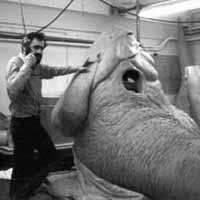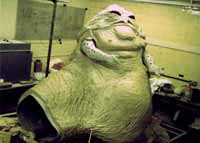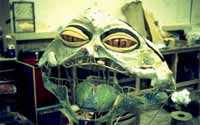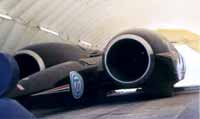


Custom Search
|
A Sluggish Project |
By Kat
Staff Writer
July 1, 2010
| Everyone loves to hate the slimy, slug-like Star Wars villain Jabba the Hutt. Sculptor John Coppinger helped bring Jabba to life in Return of the Jedi, but it wasn't easy. Among the largest puppets attempted at the time, the Jabba project often proved to be a creative challenge. Coppinger describes his role in the creation of Jabba the Hutt. How did you become interested in sculpting as a career? At school I wanted to study art and science which didn't work out. So I wound up making welded sculpture (when I should have been studying!) and was very lucky that the art master, Bob White, supported me and helped me get to art college. After that I got the perfect job; making scientific models for London's Natural History Museum. It was the ultimate post graduate course, because we could experiment and try out new materials and ideas. |
Can you describe how you landed your job working on Return of the Jedi? Did you find Lucasfilm or did Lucasfilm find you?
I'd worked on The Dark Crystal and knew that Stuart Freeborn was setting up his make-up shop for Jedi. I got an interview, made up a folio, and persuaded him to employ me! He liked the link between restoring fossil animals for the museum and creating alien creatures. So it was art and science again.
Describe your role in the creation of Jabba the Hutt. What did you do? Who did you work with?
There were six of us working on Jabba during his construction: Bob Bromley, Mike Osborne, Bob Keen, Richard Padbury, Jez Harris and myself. I started off the project, making the clay sculpt, then we all worked on internal structures and mechanisms. As he came together we began working with the performers who would be inside--Dave Barclay, Toby Philpott and Mike Edmonds. So my main job was as the sculptor, then I also helped design and build his internal 'skeleton' and skull, his tail, eyes and face mechanisms.
| How long did it take to sculpt the full size Jabba? My memory is hazy because we were doing long hours from the start! But I think it was about six weeks, including revisions; when Stuart asked me to try out different looks, particularly for his head and eyes. What challenges or obstacles did you have to overcome along the way? Just about everything! Jabba was the likely the largest puppet attempted at the time; certainly with eight or nine people operating him. Nearly every aspect of his construction and materials took some degree of research and development. In other words, lots of knuckle biting till we came up with ideas that worked. But that was also the best thing about the project--Jabba wasn't just big, he was a technical and artistic frontier all on his own! One of the biggest challenges was making such huge foam latex pieces, and Tom McLaughlin, the foam wizard, experimented with ways to do that. |
Describe an average day on the Return of the Jedi set for you.
Well, first thing was to get in early! Last one in got the 'snot' syringe; to put slime up Jabba's nose and around his mouth before each shot. The performers climbed inside him, from under the set, and some of our team worked cables and air bags from below. At least three of us were out front; two on radio sets (eyes and face expressions) and one for the slime! We took turns but I mostly grabbed the radio set for the eyes
I usually managed to get in before anyone else was around, to change the batteries and test the radios. Every time I opened the eyes, and Jabba 'woke up' to stare at me, it made me jump. I guess that was when I knew we'd managed to bring the strange old bandit to life!
I think the best compliment any of us ever got was from David Tomblin, the 1st AD [Assistant Director], who pushed past us with a brusque 'you did a good job on that thing'. It was an education to watch him work the apparent chaos into a coherent set of shots. And we knew he knew how Jabba worked, despite being just one element in a huge project, and would help us rather than shout if anything went wrong. Thankfully nothing did.
How did you become involved in Episode I: The Phantom Menace?
Nick Dudman was in Stuart Freeborn's team on Jedi--his main job was the make-up and prosthetics for Bib Fortuna. By the time Phantom Menace came round he was a crew boss in his own right, and he employed me as a sculptor.
What was the same and what was different about working on Episode I?
It was strange and nostalgic--the sets had all the same atmosphere and smell of Jedi but of course most were a lot smaller; because they were designed to be slotted into vast CGI architecture or landscapes.
What was one of the most fun sculpting projects for you and why?
Impossible question! My two favourite creatures are Jabba and the Diva (The Fifth Element) so I guess that answers it in a way. Beast and the Beauty!
What's the most common question you get or misconception people have about your job?
I suppose the idea that it's endlessly glamourous. But I remember a freezing, boring Sunday afternoon on a Harry Potter set when I thought, "I might be cold and bored, but I am in the Forbidden Forest." Another time (being an airship enthusiast) I took a short cut through a new Indiana Jones set and realised I'd walked onto the main deck of the Hindenburg!
And visitors are sometimes upset by the idea that a clay sculpt is thrown away after being moulded. But this is just part of the process in making a film creature, or any sculpture that isn't going to be fired in a kiln.
| Is there anything else our readers should know about you or any of your projects? My greatest adventure was getting to work on Thrust SSC, the land speed record car, in 1997. There is a link back to films, and Jabba in particular, because the car was essentially a one-off research vehicle and the excitement (plus quite a lot of fear!) was in seeing it run and hoping it would all work. Of course it did. And Andy Green got a ticket from the local Marshall for exceeding the speed of sound! |
What's next for you?
I'm going back to making my own sculptures, writing and lecturing. Working on films allowed me to buy back some time between projects, but now I'm getting older time is more available!
A big thanks to John Coppinger for taking the time to share his story with SWBookZone.com. See John in person at Star Wars Celebration V in Orlando, Florida (August 12-15). For more information, visit John Coppinger's website at johncoppinger.com.
Back to Star Wars Interviews
PRIVACY POLICY



